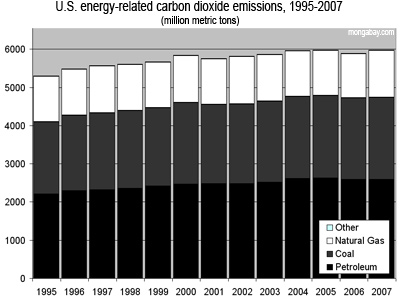U.S. carbon dioxide emissions reach record high in 2007
U.S. carbon dioxide emissions reach record high in 2007
mongabay.com
May 21, 2008
|
|
U.S. carbon dioxide emissions rose 1.6 percent in 2007 to a new record reported the Department of Energy’s Energy Information Administration (EIA).
Total U.S. carbon dioxide emissions from fossil fuels reached 5,984 million metric tons, up from 5,888 million metric tons in 2006.
EIA data showed an increase in emissions from natural gas and coal in 2007, but a drop in emissions from the use of oil.
U.S. CO2 emissions are now 19.4 percent above 1990 levels.
 U.S. energy-related carbon dioxide emissions, 1995-2007 |
Electricity generation continues to be the largest source of emissions in terms of primary energy consumption, followed by transportation, and industrial, residential, and commercial use. Transportation emissions have grown at about the same rate as electric power emissions since 1990, while direct-use emissions in the residential, commercial and industrial sectors have remained relatively flat since 1990.
In a hopeful sign, energy CO2 intensity (carbon dioxide emissions per unit of economic output) fell by about 0.5 percent as the economy expanded by 2.2 percent but emissions grew only 1.6 percent. Between 1990 and 2006, total greenhouse gas emissions per unit of GDP declined by 27.7 percent.
Despite the gains in carbon intensity, power generation became less efficient in 2007 due to a decline in the proportion of energy generated from hydroelectric dams. Drier-than-normal conditions meant that power companies had to make up the shortfall by burning more natural gas and goal. Overall emissions from the power sector rose 3 percent, while electricity generation rose 2.5 percent.
The U.S. is the world’s second largest emitter of carbon dioxide after China. CO2 emissions from China surpassed those of the U.S. in 2006.